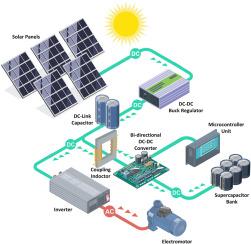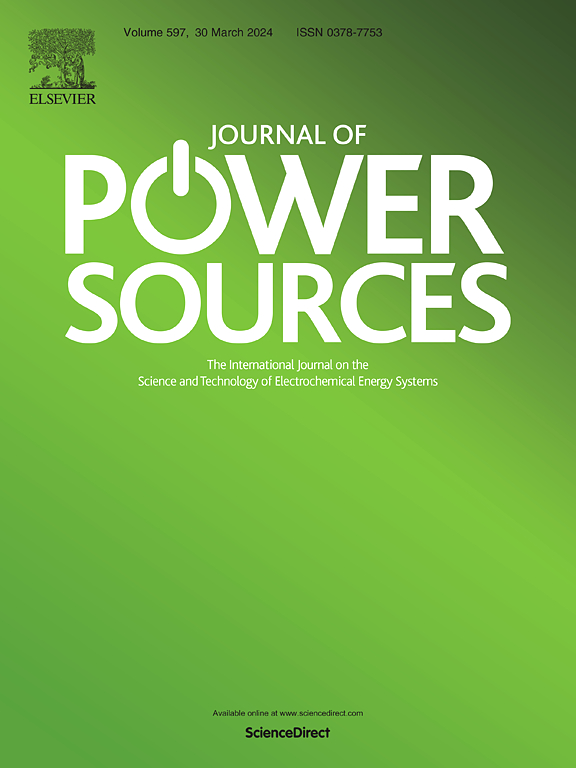利用基于超级电容器的充电泵启动无电池离网光伏电动机负载
IF 8.1
2区 工程技术
Q1 CHEMISTRY, PHYSICAL
引用次数: 0
摘要
使用离网光伏(PV)启动电动马达(EM)负载总是充满挑战。因为它们的启动电流会使光伏电压下降,导致转换器不稳定。一个实用的解决方案是使用电池作为备用,但重复的浪涌电流会降低电池的使用寿命。本文提出了一种基于超级电容器组(SCB)的电荷泵,以解决离网无电池光伏发电的稳定性问题。它包含一个通过双向 DC/DC 转换器连接到逆变器直流链路的 SCB。SCB 首先由光伏电池预充电。然后在启动电动机负载(EM)时,为直流链路电容器提供脉冲电流。这里的主要挑战是如何控制 SCB 的充放电电流。在建议的方法中,首先通过电路分析建立系统模型。然后获得一个预定义的充电模式,以受控电流对 SCB 进行从零到额定电压的充电,且无瞬态浪涌。当注入脉冲电流作为充电泵时(SCB 放电模式),在预先确定的周期内采用恒定占空比开关,以确保转换器在升压模式下的稳定性。为了获得最佳效果,在脉冲电流注入和负载启动之间进行了时间转换,作为预充电阶段。运行 70 瓦通用电机的 100 瓦系统原型的实验结果表明,在负载启动前 50 毫秒开始注入 2 安培/200 毫秒的脉冲电流,可将直流链路电压偏差控制在 10 % 以下,并且不会出现瞬态电流。本文章由计算机程序翻译,如有差异,请以英文原文为准。

Starting electro-motor loads in battery-less off-grid photovoltaics using a super-capacitor based charge-pump
Starting Electromotor (EM) loads with off-grid photovoltaics (PV) is always challenging. Because their starting current makes the PV voltage fall, leading to converter instability. A practical solution is using batteries as a backup, but the repeating inrush current lowers the battery lifespan. This paper proposes an electrical charge pump based on a super-capacitor-bank (SCB) to fix the stability issue in off-grid battery-less photovoltaics. It contains an SCB connected to the DC-link of the inverter via a bi-directional DC/DC converter. The SCB is first pre-charged from the PV. Then at the moment of starting an electromotor load (EM), it supplies the DC-link capacitor with a pulse current. The main challenge here is to control the charging/discharging current of the SCB. In the proposed method, the system model is first developed by circuit analysis. Then a pre-defined charging pattern is obtained to charge the SCB from the zero to nominal voltage with a controlled current with no transient inrush. When injecting the pulse current as a charge pump (SCB discharging mode), constant duty-cycle switching for a pre-defined period is applied to ensure the converter stability in boost mode. To get the best results, a time shift is implemented between the pulse current injection and the load start-up, as a pre-charging phase. Experimental results from a 100 w system prototype running a 70 w universal motor show that a 2 Amp/200 ms pulse current, starting 50 ms before the load start-up, keeps the DC-link voltage deviation under 10 %, and no current transient is observed.
求助全文
通过发布文献求助,成功后即可免费获取论文全文。
去求助
来源期刊

Journal of Power Sources
工程技术-电化学
CiteScore
16.40
自引率
6.50%
发文量
1249
审稿时长
36 days
期刊介绍:
The Journal of Power Sources is a publication catering to researchers and technologists interested in various aspects of the science, technology, and applications of electrochemical power sources. It covers original research and reviews on primary and secondary batteries, fuel cells, supercapacitors, and photo-electrochemical cells.
Topics considered include the research, development and applications of nanomaterials and novel componentry for these devices. Examples of applications of these electrochemical power sources include:
• Portable electronics
• Electric and Hybrid Electric Vehicles
• Uninterruptible Power Supply (UPS) systems
• Storage of renewable energy
• Satellites and deep space probes
• Boats and ships, drones and aircrafts
• Wearable energy storage systems
 求助内容:
求助内容: 应助结果提醒方式:
应助结果提醒方式:


